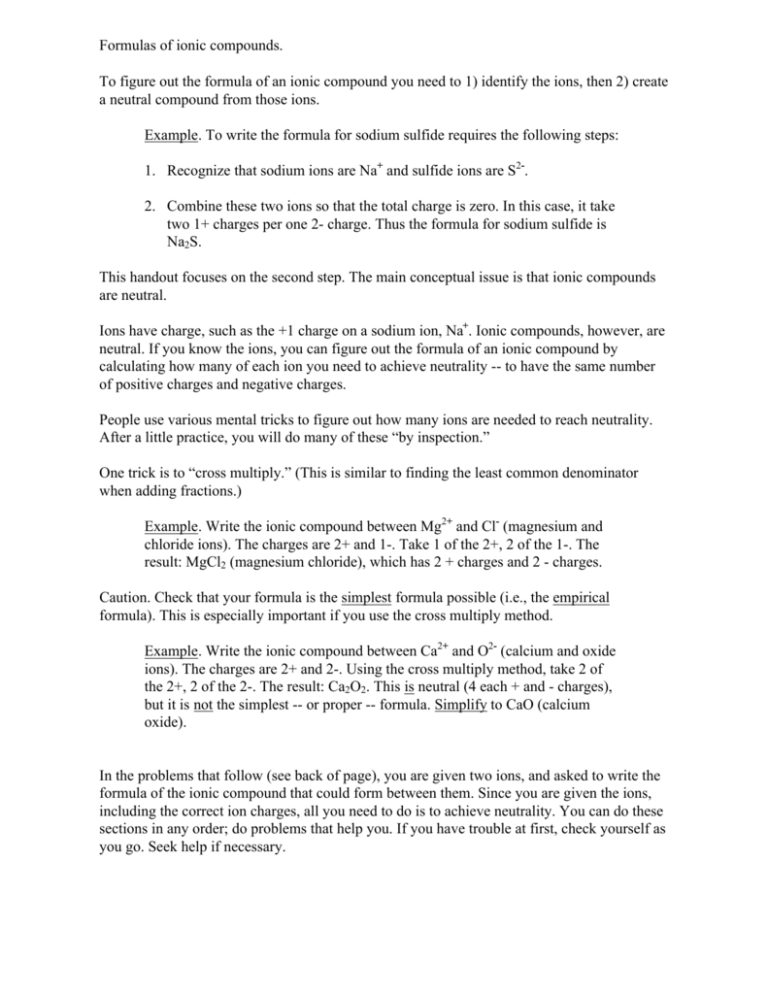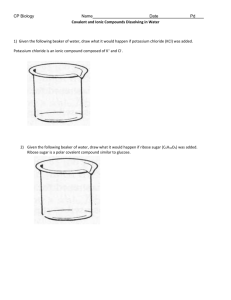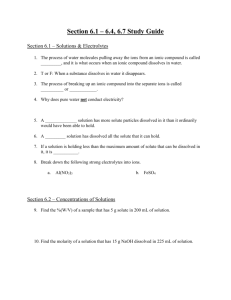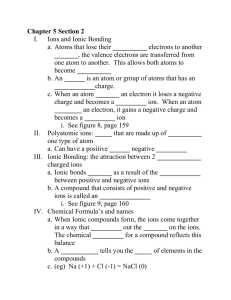Formulas of ionic compounds. To figure out the formula of an ionic
advertisement

Formulas of ionic compounds. To figure out the formula of an ionic compound you need to 1) identify the ions, then 2) create a neutral compound from those ions. Example. To write the formula for sodium sulfide requires the following steps: 1. Recognize that sodium ions are Na+ and sulfide ions are S2-. 2. Combine these two ions so that the total charge is zero. In this case, it take two 1+ charges per one 2- charge. Thus the formula for sodium sulfide is Na2S. This handout focuses on the second step. The main conceptual issue is that ionic compounds are neutral. Ions have charge, such as the +1 charge on a sodium ion, Na+. Ionic compounds, however, are neutral. If you know the ions, you can figure out the formula of an ionic compound by calculating how many of each ion you need to achieve neutrality -- to have the same number of positive charges and negative charges. People use various mental tricks to figure out how many ions are needed to reach neutrality. After a little practice, you will do many of these “by inspection.” One trick is to “cross multiply.” (This is similar to finding the least common denominator when adding fractions.) Example. Write the ionic compound between Mg2+ and Cl- (magnesium and chloride ions). The charges are 2+ and 1-. Take 1 of the 2+, 2 of the 1-. The result: MgCl2 (magnesium chloride), which has 2 + charges and 2 - charges. Caution. Check that your formula is the simplest formula possible (i.e., the empirical formula). This is especially important if you use the cross multiply method. Example. Write the ionic compound between Ca2+ and O2- (calcium and oxide ions). The charges are 2+ and 2-. Using the cross multiply method, take 2 of the 2+, 2 of the 2-. The result: Ca2O2. This is neutral (4 each + and - charges), but it is not the simplest -- or proper -- formula. Simplify to CaO (calcium oxide). In the problems that follow (see back of page), you are given two ions, and asked to write the formula of the ionic compound that could form between them. Since you are given the ions, including the correct ion charges, all you need to do is to achieve neutrality. You can do these sections in any order; do problems that help you. If you have trouble at first, check yourself as you go. Seek help if necessary. Formulas of ionic compounds. Page 2 Problems A. This section uses imaginary ions. Thus you can work here on neutrality without even having to think about real chemicals. (Real ions rarely have a charge greater than ±3. Imaginary ions, of course, do not have this restriction. Good practice!) 1. A+ and R24. G4+ and Q7. D2+ and X410. E3+ and R2- 2. A+ and T35. G4+ and R28. D2+ and T311. G4+ and T3- 3. E3+ and Q6. D2+ and R29. D2+ and Z512. G4+ and Z5- B. This section uses real monatomic ions. Most of these are common ions that you should be able to figure out from the periodic table; however, you are given the ions, including the charge. All you need to do is to achieve neutrality. 13. Na+ and S216. Pb4+ and Cl19. Al3+ and Br22. Al3+ and S2- 14. Na+ and N317. Pb4+ and O220. Ca2+ and N323. Al3+ and N3- 15. Al3+ and Cl18. Ca2+ and S221. Ca2+ and Br24. Mg2+ and P3- C. This section uses real (and common) ions, including both monatomic and polyatomic ions. Note that all the polyatomic ions shown here are ones you should know. 25. Na+ and SO4228. NH4+ and Br31. Ca2+ and CO3234. NH4+ and S2- 26. Na+ and PO4329. Mg2+ and SO4232. Ca2+ and PO4335. Pb2+ and OH- 27. K+ and PO4330. Al3+ and NO333. Ca2+ and NO336. NH4+ and SO42- Sect A. 1. A2R 4. GQ4 7. D2X 10. E2R3 2. A3T 5. GR2 8. D3T2 11. G3T4 3. EQ3 6. DR 9. D5Z2 12. G5Z4 Sect B. 13. Na2S 16. PbCl4 19. AlBr3 22. Al2S3 14. Na3N 17. PbO2 20. Ca3N2 23. AlN 15. AlCl3 18. CaS 21. CaBr2 24. Mg3P2 Sect C. 25. Na2SO4 28. NH4Br 31. CaCO3 34. (NH4)2S 26. Na3PO4 29. MgSO4 32. Ca3(PO4)2 35. Pb(OH)2 27. K3PO4 30. Al(NO3)3 33. Ca(NO3)2 36. (NH4) 2SO4 Answers x11\ionic 9/27/02








